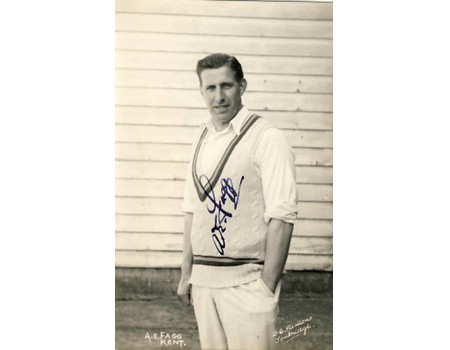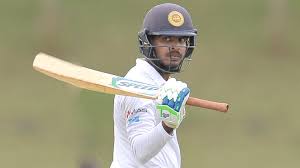In February this year, the 28 year old Sri Lankan batsman Angelo Perera, captaining the Nondescripts against the Sinhalese Sports Club in a first-class Premier League domestic game, scored 201 in the first innings and 231 in the second innings, to become only the second man in history to score two double hundreds in one game. The pitch was described as ‘flat’, with the lowest team total 444, and the game ended in a draw. That was not the only high-scoring game in the Sri Lankan Premier League this season. In all, 14 double centuries had been hit in Sri Lankan domestic cricket in the 2018/19 season up to and including Perera’s innings, so you could argue that high scoring at this level was the norm rather than a great exception.
So the 80 year old record of the then 23 year old Arthur Fagg is unique no more. Scoring one double century is tough enough, but having enough time as well as enough talent to score two in a match is extremely rare. It was in 1938, against Essex at Colchester on July 13th, 14thand 15th that Arthur Edward Fagg became the first man to achieve this feat. Since then two people have made a triple century and a single century in the same match, another well nigh impossible task, mainly because there is never likely to be time to do it.

Arthur Fagg
Fagg, who had been well below his best in 1937 after contracting rheumatic fever on the MCC tour of Australia in 1936/37, batted superbly throughout the season of 1938. At Colchester, he opened the batting and in the first innings made 244 out of a total of 429. Wisden stated that the Essex bowling was not at its usual strength because of the Gentlemen v Players match taking place at Lord’s at the same time, which meant that their fine and tragic fast bowler Ken Farnes was not playing, but equally Kent were without Frank Woolley for the same reason. “Vigorous on-drives and powerful strokes to leg were his chief means of scoring”, said Wisden. He scored 31 fours in his first innings and 27 in the second. It is worth noting that the Kent first innings, which lasted for 122.1 overs, was over by 6 pm on the first day, leaving Essex a worrying few overs to finish off the day, but they survived to be 12 for no wicket overnight. The following day, Kent dismissed Essex for 350, with Tom Pearce hitting 137 not out, and Doug Wright taking 7 for 107 in 31.3 overs. The whole innings had lasted 103.3 overs, but there was still plenty of time left in the day for Kent to rattle up 142 for no wicket, with Fagg already into three figures on 104 not out. It had taken him a mere 69 minutes to reach his hundred.
The next morning, with the score on 283, Essex finally managed to take a wicket when Peter Sunnucks was run out for 82, and with Fagg in the 190s, the number ten Alan Watt was sent in to keep him company while he reached his double double century. The pair put on 30, of which Watt made 24, before Fagg completed his remarkable feat and finished on 203 not out. Watt finished on 24 not out in both innings, a rather less amazing but vaguely interesting statistical record. Essex batted again, needing almost 400 to gain an unlikely victory, but at 8 for 2 the rain intervened, and the match was left drawn.
In 1938 Fagg scored almost 2,500 runs and made 9 centuries and, in Wisden’s words “reached the standard expected of him two years previously”. But he was unfortunate in playing at the same time as many great opening batsmen – Hutton and Washbrook for a start – and he only played five times for England, and never after the war, when he was probably in his prime. His highest score in eight Test innings was only 39. In his whole career, which lasted from 1932 until 1957, he scored 27,291 runs at an average of 36.05, including 58 centuries, of which over 26,000 were scored for Kent. An odd quirk of his career is that although he scored six double centuries for Kent, only one of them was scored within the county, and that at Dover’s Crabble ground, against Middlesex in 1948. Arthur Fagg’s run tally puts him fifth on the list of Kent’s most prolific batsmen, and he is also third on the list of Kent’s catchers, and sixth on the list of Kent’s youngest players on debut – he was just 17 years and 25 days old when he made his debut against Warwickshire in 1932. After his retirement from playing, he became an umpire and stood in eighteen Tests between 1967 and 1976, earning a reputation as a strict but expert arbiter. He died on 13 September 1977, aged only 62, having suffered from poor health for some years.
It’s a bit of a surprise that there is not a part of the Canterbury ground named after him, but we have run out of buildings to name after somebody, and although there are gates and even ends which could bear famous cricketers’ names (think Jimmy Anderson at Old Trafford), I suppose it would be a bit silly to have a Fagg End, just as it would be daft to have a Billings Gate. But even without any permanent reminder of Arthur Fagg at Canterbury, he should not be forgotten. Two double centuries in a game is a very rare achievement, and even if it is no longer unique, Arthur Fagg was the first to do it, and he did it for Kent. Angelo Perera can never match that.
 Angelo Perera
Angelo Perera
Hello
Could I have permission to use the signed photo of Arthur Fagg in my forthcoming book on Cricket during the Second World War please?
johnbroom@aol.com